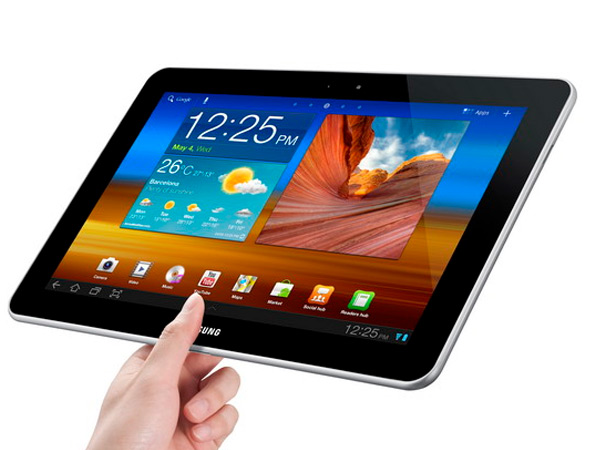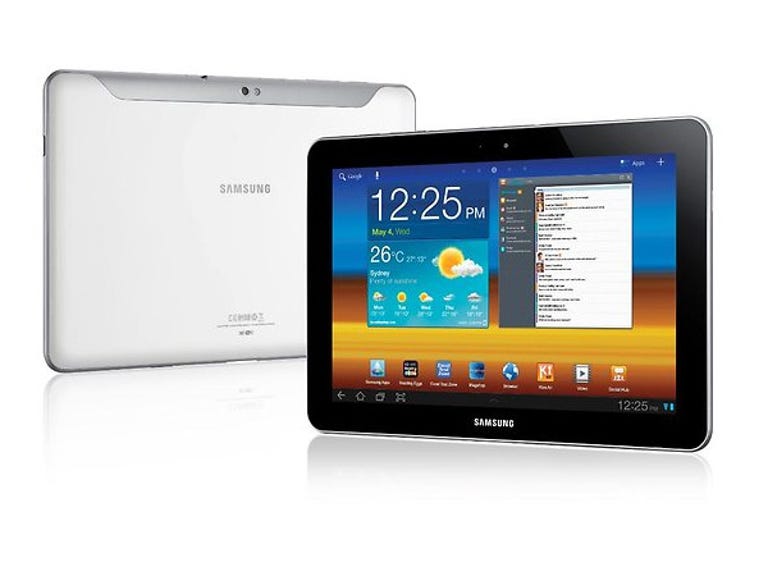 Why You Can Trust CNET
Why You Can Trust CNET Samsung GalaxyTab 10.1 review: Samsung Galaxy Tab 10.1 (3G, 16GB)
The Galaxy Tab 10.1 is a great-looking tablet computer, but Samsung makes little attempt to differentiate its Android tablet from the rest of the pack.
The introduction of the Galaxy Tab 10.1 has been the most dramatic of any consumer electronics device in recent memory, with Apple dragging Samsung through court and blocking the sale of the Tab, only to have the injunction lifted a few weeks later. The Galaxy Tab 10.1 is the tablet that Apple didn't want you to see, let alone buy. But does this automatically mean that the 10.1 is the tab you've been waiting for?
The Good
The Bad
The Bottom Line
Design
Full marks to Samsung's design and engineering teams; the Galaxy Tab 10.1 is seductively thin and wonderfully lightweight. Android tablets this year have suffered from being exactly the opposite, with Motorola's Xoom weighing in at nearly 50 per cent heavier, for example. With the core purpose of a tablet computer centring on its portability, the weight of a tablet is central to its success, and the 10.1 passes this test with flying colours.
Speaking of colour, Samsung's 10.1-inch display is a treat for the eyes, with great viewing angles and enough pixels in its 800x1280-pixel resolution to render sharp, clear pictures and text onscreen. Owners of Samsung's Galaxy S II might be slightly disappointed with the difference in contrast between the AMOLED screen on the phone and the PLS LCD panel used in the tablet, but the black levels and clarity are really very good for a screen of this size at this price.

The Galaxy Tab is as thin and light as this picture suggests.
(Credit: Samsung)
Android fans following the progress of Honeycomb tablets throughout 2011 will notice a distinct absence of ports and sockets around the edge of the Galaxy Tab 10.1. To keep its svelte waistline to 8.6mm, we didn't expect Samsung to include a full-sized USB port, but it is more disappointing that there is no micro-USB port — which is the industry connectivity standard. There's also no expandable memory (several other Android tablets feature an SD card slot) and no TV-out port, like micro HDMI.
Samsung takes the Apple approach to connectivity in the Galaxy Tab 10.1, and will disappoint anyone who has been avoiding the iPad for exactly this reason. Like the iPad, the Galaxy Tab ships without these extra connectivity options, and, like the iPad, users can choose to add these features with expensive adapters. A quick browse of the Samsung US website shows individual adapters ranging in price between US$20 and US$40, which is a lot to pay when the other tablets offer this functionality for free.
User experience and performance
Although Samsung has added a custom layer to the basic Android Honeycomb user experience, the feel of using the Galaxy Tab 10.1 is mostly identical to using any other Honeycomb tablet. Samsung's refinements extend to the system fonts, a collection of widgets and a user-customisable shortcuts panel on the taskbar at the bottom of the screen. These adjustments do add to the user experience, but not as much as we'd like. The Honeycomb user experience is far from perfect, and Samsung's TouchWiz makes only a minor contribution in rectifying this.
Touchwiz adds a few nice tweaks, like the shortcuts taskbar.
(Credit: Screenshot CBSi)
Using the tablet is a pleasant experience, with Samsung's capacitive touchscreen working well, and the onscreen keyboard presenting large enough virtual keys to make typing a fairly painless experience.
Powering the Galaxy Tab 10.1 is Nvidia's dual-core Tegra 2 processor and 1GB of RAM. This is the default configuration for Android Honeycomb tablets this year, with the same hardware found in the Motorola Xoom, the Acer Iconia A500 and the Sony Tablet S. Performance for the 10.1 then matches its competition, but fails to better it. For most of the time, the system performance is fine, but you'll notice regular stutters in animations and a noticeable pause when you exit an application and return to the home screen.
We experience two-day battery life using the Galaxy Tab reasonably frequently for web browsing and playing 3D games, like Shadowgun. To push the battery further, we set the brightness to full, switched off wireless connectivity and looped a 720p HD video file. Under these conditions, the Tab lasted for about 5.5 hours before requiring a recharge. In comparison, the iPad 2 will play the same video file for 7.5 hours with its brightness ramped up to maximum.
Camera
No one will be choosing a tablet computer based on the quality of its camera, but, for what it's worth, here are a couple of examples of photos taken on the Galaxy Tab 10.1.
(Credit: CBSi)
(Credit: CBSi)
Compared to other Android tablets
| Samsung Galaxy Tab 10.1 | ASUS Eee Pad Transformer | Motorola Xoom | Sony Tablet S |
|---|---|---|---|
| Nvidia Tegra 2 | Nvidia Tegra 2 | Nvidia Tegra 2 | Nvidia Tegra 2 |
| 10.1-inch screen 800x1280 pixels | 10.1-inch screen 800x1280 pixels | 10.1-inch screen 800x1280 pixels | 9.4-inch screen 800x1280 pixels |
| 1GB RAM | 1GB RAM | 1GB RAM | 1GB RAM |
| Proprietary port | microSD, microUSB, USB Host, microHDMI, SD Card | microSD, microUSB, microHDMI | microSD, microUSB, Infrared |
If you're in the market for an Android tablet this year, you're not short on choices. A visit to your local JB Hi-Fi will present you with six Android alternatives to the Galaxy Tab 10.1, each looking fairly similar, and each offering something a little different.
Samsung sets itself apart primarily in its design, with the Galaxy Tab slinking in with its total weight being 100g lighter, and being 5mm slimmer than its nearest competitor, the Asus Transformer. This is an important factor, to be sure, but is it the only factor you need to consider? If you're looking for a tablet for web browsing and media consumption only, then the size and weight should be your top priorities, but if you're looking for a tablet suitable for taking to work, you should look a little further.
The absence of standard USB connectivity, expandable memory and a ready TV-out option are the great shortcomings of the Tab 10.1. All of the alternatives include expandable memory, some with a full-sized SD-card slot, and all but the Sony Tablet S feature micro HDMI-out for connecting to TVs, projectors and computer monitors. You'll have to ask yourself whether you need these features or not, but it is a shame that Samsung doesn't offer these out of the box, especially when you consider that the Galaxy Tab is amongst the most expensive of the Android tablets.
Galaxy Tab vs. iPad 2
They sort of look the same?
(Credit: CBSi/Samsung/Apple)
The million-dollar question is how the Galaxy Tab 10.1 stacks up next to Apple's iPad 2. With Apple dominating the tablet sales market, it's not surprising that Samsung should try to replicate Apple's successful iPad formula, but we are a bit bewildered by just how similar Samsung's approach is. No, we're not suggesting that Samsung is copying Apple's precious intellectually property (that's for the courts to decide), but if you compare the Galaxy Tab 10.1 and the iPad 2 based on features and price, there is very little between them.
Samsung has price matched the iPads across all of the variations of the device, and follows Apple's lead in not including a long list of important computing features, leaving customers to pay extra for adapters to return certain functions to the tablet that we believe should be in the tablet to begin with. If you're a photographer and want to mount an SD memory card, you'll hand over an extra US$29.99. If you want to use your Galaxy Tab for presentations, you'll need a US$40 HDTV adapter, plus a micro-HDMI-to-HDMI cable.
The big difference between the iPad and the Galaxy Tab is the software, however, and with those you can argue the pros and cons of Android vs. iOS until the end of days, but you can't argue with the fact that there are tens of thousands of apps designed specifically for the iPad, including Apple's excellent Garage Band music creator, while there are few stand-out tablet apps for Android. When the two devices are priced the same and share a look and feel, this should be an important consideration for a savvy tablet shopper this year.
Overall
The Galaxy Tab 10.1 is an extremely desirable device limited by a lack of computing features common in other Android tablets. The Galaxy Tab is the thinnest and lightest, but you'll pay a premium for this design, and you'll go without expandable memory, a standard USB connection and an HDMI port. Plus, there's no killer feature or app that helps the Galaxy Tab stand apart from any of the other tablets available. The Asus Transformer has its keyboard dock, the Lenovo ThinkPad has its digitiser pen and the Sony Tablet S has easy DLNA sharing and infrared for controlling TVs. These aren't just extra features; these are tools that suggest the way each tablet could be used, and are factors that elevate these devices beyond merely being larger versions of the smartphones already in our pockets.
We also have to consider that new tablets will be entering the market in a matter of months; tablets with quad-core processors and new versions of Google's Android OS. With the trouble Samsung has had getting the 10.1 into Australia this year, some may say that its arrival is better late than never, but for us it just feels late, and we'd suggest waiting for the next wave of Android tablets to arrive in the new year.
Like the pretty faces draping the covers of gossip magazines, the Galaxy Tab looks better than its peers, but is decidedly average below the surface. Users of the 10.1 will enjoy good web browsing, gaming and media playback, but the same can be said for the majority of devices in this category.


